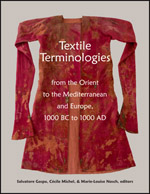Center, Textile Research

Textile Terminologies from the Orient to the Mediterranean and Europe, 1000 BC to 1000 AD
Date of this Version
2017
Document Type
Article
Citation
In Textile Terminologies from the Orient to the Mediterranean and Europe, 1000 BC to 1000 AD, ed. Salvatore Gaspa, Cécile Michel, & Marie-Louise Nosch (Lincoln, NE: Zea Books, 2017), pp. 451-482.
doi:10.13014/K2RN361H
Abstract
This paper investigates key Japanese words related to textiles and their production in ancient Japan that is during the 1st millennium AD. At this time the language known as ‘Old Japanese’ evolved and eventually systems for writing it down emerged, based on borrowing the Chinese characters. Textiles used for clothing, coverings, tax items, and ritual objects played an integral role in the society, and thus terms related to textiles provide insight into the life style, politics, religion and economy of Japan as it emerged from a tribal-based localized society into a centralized nation state. The linguistic study also points to cultural pathways along which inventions, materials, and processes passed, tying the island country to the distant areas on the neighboring continent. Words, their meanings, and their written forms change over time, making it difficult to pinpoint clear definitions. We have therefore approached the subject from several directions in hopes that superimposing the information from each will help clarify the picture. The core of the essay presents terms in the textile section of the earliest Japanese dictionary. It supplements these with examples of the use of the words in ancient Japanese literary resources and with iconography. The second half turns to actual tools excavated at sites ranging from the 1st millennium BC through the 1st millennium AD.
The earliest use of Chinese characters in Japan appears as inlaid inscriptions found on some excavated iron swords and cast bronze mirrors dating to around the 5th century AD. Until then the Japanese had no writing system, though China already had a well-developed one and a nationwide political system. Inscriptions found on wooden tablets and Buddhist sculptures show that in Japan a systematic writing system started about the early 7th century AD at the same time as a nationwide administrative system has emerged. It is believed that the innovative Japanese use of Chinese characters merely for their sound, known as Man’yōgana, in order to express elements of their grammar not found in Chinese, such as particles, started about the late 7th century. The terms concerning textile materials and production first appeared in the Chronicles of Japan such as Kojiki (edited in AD 712) and Nihon Shoki (edited in AD 720). These texts trace the genealogy of the imperial family from historical figures back to mythological times. In the former text, for example, the fiber of wisteria (fuji in Japanese) is mentioned as a material for weaving, and the Japanese madder (akane in Japanese) as a dye material. In the latter, textile terms are reflected in the names of families or clans attached to the Court or government during the Asuka period (6th-7th centuries AD), such as Nishikgoribe Kinunuibe
Included in
Ancient History, Greek and Roman through Late Antiquity Commons, Art and Materials Conservation Commons, Classical Archaeology and Art History Commons, Classical Literature and Philology Commons, Fiber, Textile, and Weaving Arts Commons, Indo-European Linguistics and Philology Commons, Jewish Studies Commons, Museum Studies Commons, Near Eastern Languages and Societies Commons, Other History of Art, Architecture, and Archaeology Commons


Comments
Copyright © 2017 Salvatore Gaspa, Cécile Michel, & Marie-Louise Nosch. Photographs copyright as noted.